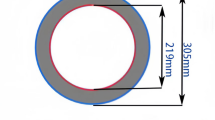Abstract
This study aims to present the mechanical behavior of carbon fiber reinforced polymers (CFRP) reinforced low strength cylindrical and prism concrete specimens under both heating–cooling cycles and sustained loading. Heating–cooling cycles range from −10 to 50°C and the applied sustained load level is 40% of the ultimate strength of concrete. After 200 heating–cooling cycles and/or sustained load testing, specimens were tested to determine the mechanical behavior under uniaxial compression. The experimental test results show that heating–cooling cycles alone have insignificant effect on the mechanical properties of CFRP-wrapped specimens. However, as for simultaneous exposure of sustained loading and heating–cooling cycles the main difference is on the shape of the stress–strain diagram, in which the bilinear response becomes clear. The other difference is on the ultimate strain, which decreases up to 29 and 15% for cylindrical and prismatic specimens, respectively.














Similar content being viewed by others
References
ACI440R-07 (2008) Report on fiber-reinforced polymer (FRP) reinforcement for concrete structures. American Concrete Institute Committee 440, Third Printing, July 2008
Bakis CE, Bank LC, Brown VL, Cosenza E, Davalos JF, Lesko JJ, Machida A, Rizkalla SH, Triantafillou TC (2002) Fiber-reinforced polymer composites for construction—state-of-the-art review. J Compos Constr ASCE 6(2):73–87
Ilki A, Kumbasar N, Koç V (2002) Strength and deformability of low strength concrete confined by carbon fiber composite sheets. In: Proceedings of the 15th ASCE engineering mechanics conference, New York, On CD. Paper no: 101
Lam L, Teng JG (2003) Design-oriented stress–strain model for FRP-confined concrete. Constr Build Mater 17:471–489
Lam L, Teng JG (2003b) Hoop rupture strains of FRP jackets in FRP confined concrete. In: Proceedings of the FRPRCS-6, Singapore, pp 601–612
Samaan M, Mirmiran A, Shahawy M (1998) Model of concrete confined by fiber composites. J Struct Eng 124(9):1025–1031
Shahawy M, Mirmiran A, Beitelman T (2000) Tests and modeling of carbon-wrapped concrete columns. Composites B 31:471–480
Masia MJ, Gale TN, Shrive NG (2004) Size effect in axially loaded square-section concrete prisms strengthened using carbon fiber reinforced polymer wrapping. Can J Civ Eng 31:1–13
Wang LM, Wu YF (2008) Effect of corner radius on the performance of CFRP-confined square concrete columns: test. Eng Struct 30:493–505
Al-Salloum YA (2007) Influence of edge sharpness on the strength of square concrete columns confined with FRP composite laminates. Composites B 38:640–650
Mirmiran A, Shahawy M, Samaan M, El-Echary H, Mastrapa JC, Pico O (1998) Effect of column parameters on FRP-confined concrete. J Compos Constr 2(4):175–185
Toutanji HA, Balaguru P (1999) Effects of freeze–thaw exposure on performance of concrete columns strengthened with advanced composites. ACI Mater J 96(5):605–610
Toutanji HA (1998) Durability characteristic of concrete columns confined with advanced composite materials. Compos Struct 44:155–161
Kshirsagar S, Lopez-Anido RA, Gupta RK (2000) Environmental aging of fiber reinforced polymer wrapped concrete cylinders. ACI Mater J 97(6):703–712
Karbhari VM, Rivera J, Dutta PK (2004) Effect of short-term freeze–thaw cycling on composite confined concrete. J Compos Constr 4(4):191–197
Karbhari VM (2002) Response of fiber reinforced polymer confined concrete exposed to freeze and freeze–thaw regimes. J Compos Constr 6(1):35–40
Saenz N, Pantelides CP (2006) Short and medium term durability evaluation of FRP-confined circular concrete. J Compos Constr 10(3):244–253
Ersoy U, Tankut T, Özcebe G (2004) Reinforced concrete. METU Press, Ankara
Naguib W, Mirmiran A (2002) Time-dependent behavior of fiber-reinforced polymer-confined concrete columns under axial loads. ACI Struct J 99(2):142–148
Theriault M, Pelletier MA, Khayat K, Al Chami G (2003) Creep performance of CFRP confined concrete cylinders. In: Proceedings of the FRPRCS-6, Singapore, pp 623–632
Kong A, Fam A, Green M F (2005) Freeze–thaw behavior of FRP-confined concrete under sustained load. In: Proceedings of the FRPRCS-7, Kansas City, pp 705–722
Green MF, Bisby LA, Fam AZ, Kodur VKR (2006) FRP confined concrete columns: behavior under extreme conditions. Cem Concr Compos 28:928–937
Mazılıgüney L, Azılı F, Yaman İÖ (2008) In situ concrete compressive strength of residential, public and military structures. In: Proceedings of the 8th international congress on advances in civil engineering, Famagusta, Northern Cyprus, pp 273–280
Rochette P, Labossiere P (2000) Axial testing of rectangular column models confined with composites. J Compos Constr ASCE 4(3):129–136
TEC2007 (2007) Specification for structures to be built in disaster areas. Ministry of Public Works and Settlement, Government of Republic of Turkey, Ankara
ASTM C 39/C 39 M (2001) Standard test method for compressive strength of cylindrical concrete specimens. Annual book of ASTM standards. ASTM, Philadelphia
ASTM C 469 (2002) Standard test method for static modulus of elasticity and Poisson’s ratio of concrete in compression. Annual book of ASTM standards. ASTM, Philadelphia
Lam L, Teng JG (2004) Ultimate condition of fiber reinforced polymer confined concrete. J Compos Constr ASCE 8(6):539–548
Acknowledgments
The authors wish to express sincere appreciation to the Scientific and Technological Research Council of Turkey (TUBITAK) (Project No: ICTAG I599) and Middle East Technical University (BAP-08-11-DPT-2002K120510) for financing this research program.
Author information
Authors and Affiliations
Corresponding author
Rights and permissions
About this article
Cite this article
Erdil, B., Akyuz, U. & Yaman, I.O. Mechanical behavior of CFRP confined low strength concretes subjected to simultaneous heating–cooling cycles and sustained loading. Mater Struct 45, 223–233 (2012). https://doi.org/10.1617/s11527-011-9761-6
Received:
Accepted:
Published:
Issue Date:
DOI: https://doi.org/10.1617/s11527-011-9761-6




